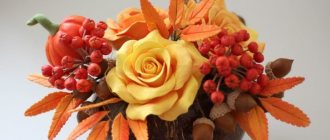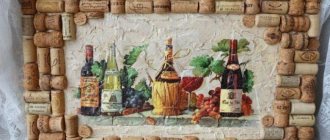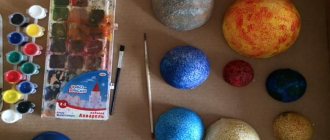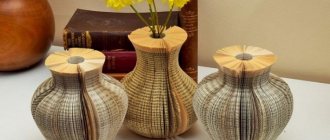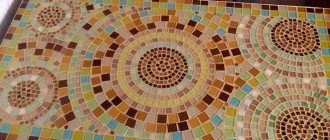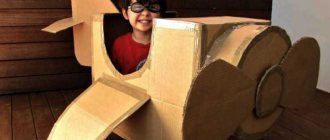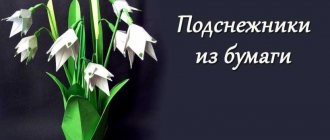Living plants not only decorate the house, but also improve its atmosphere. It is not surprising that flower arrangements have become an integral part of interiors. It is not difficult to make a suitable bouquet with your own hands - today floral fashion gravitates towards naturalness and maximum simplicity.
However, this does not mean that an armful of flowers carelessly placed in a vase can be considered a masterpiece worthy of special pride. In order for the arrangement to be truly impressive and deliver aesthetic pleasure, you need to know the basic laws of color science and shape formation.
Materials for creating a bouquet
For many, a bouquet is a collection of flowers. If these are cut buds to be kept in a vase with water, then yes. Otherwise, flowers or their imitation can be made from anything.
Most often, when thinking about how to make a craft autumn bouquet, they remember fallen leaves of different shades. She is incredibly beautiful, capable of realistically imitating any flowers.
Additionally, you can add any dried flowers, small fruits, grass, or tree branches to the bouquet. The result may have a limited shelf life or be used forever.
Simple arrangements for the home
Making compositions from fresh flowers with your own hands always begins with preparing the plants. It is necessary to completely clean the part of the stems that will be in the vase so that the water does not rot.
Then the cut is refreshed so that the flowers absorb moisture more intensively. This should only be done with pruning shears or, as a last resort, a stationery knife, but not with ordinary tailor's scissors. Otherwise, the capillaries through which water and nutrition flow through the stem to the buds will become wrinkled and deformed, and they will quickly wilt.
Lush “ruffled” arrangements are collected in the hands and only then placed in a vessel with water. This can be not only a vase, but also something less traditional - a garden watering can, a clay jug or a galvanized bucket. The flower stems are pre-tied so that the plants do not fall apart.
Garden mix
Fresh flowers from the garden itself just beg to be placed in a vase. However, so beautiful in a flowerbed, they immediately turn into a disordered mass when you try to create the simplest composition from them. Fortunately, there is an excellent life hack invented specifically for novice florists - dividing into sectors using adhesive tape.
You will need:
- any garden flowers:
- vase with a wide neck;
- narrow tape;
- scissors.
After pouring water into the vase, carefully wipe the edges with a paper towel. The tape will not stick to the wet surface of the vessel.
We cut strips of the required length and glue them to the edges of the vase in the longitudinal and transverse directions. The result should be a grid with holes approximately 2x2 cm. Now it will be much more convenient to distribute the flowers.
We start with the smallest ones, for example, spray roses or chrysanthemums. We arrange them around the perimeter using a spiral technique - the stems touch at one point and are located at an angle.
To make the mix look harmonious, it is better to select flower buds of the same color scheme - warm or cold. In this case, spray roses with a powdery gradient and orange safflower were used, and an amber-yellow sunflower served as the main accent. The desired contrast was achieved with the help of greenery, which not only effectively emphasized the buds of nuanced shades, but also created an expressive texture.
A charming summer mix will be the best decoration for a kitchen or country veranda. Drinking tea in such “company” will bring incomparable pleasure.
Arrangement in shades of burgundy
Bouquet arrangements of fresh flowers are often used to decorate wedding interiors. An interesting solution for a wine-style celebration is a combination of dark red and bluish-green plants. A luxurious arrangement on piaflora, in an antique silver vase with a high leg, is also suitable for other special occasions. It is placed in the center of the table.
The bouquet has the shape of an inverse crescent, created by the hanging branches of two varieties of eucalyptus - cineria and populus. Also used for it: anthurium, terry Wedding Gift tulips and anemones.
Before proceeding with assembly, the plants must be watered by leaving them in settled water at room temperature for several hours. After this, all the stems are cleaned, the cut is refreshed, and the components of the future floral masterpiece are laid out on the desktop by type and variety. This will allow you to assemble faster, without being distracted by searching for the right element, and the flowers will spend less time without water. The necessary tools are also placed there: pruning shears, scissors, anchor tape, floral wire and toothpicks. The last thing to pierce is the piaflora when planting tulips that have a soft stem.
We soak the floral sponge with water and attach it to the flat bowl of the vase using anchor tape. Next, we begin to form the silhouette of the arrangement using eucalyptus. To create density in the center, elderberry branches with hard, bright leaves are used.
Experienced florists recommend taking at least 3 types of greenery for European bouquets to create a play of textures and volumes.
Next, we place large anthurium buds, creating bright accents. These are the so-called focal flowers, focusing the viewer's attention on themselves.
The density in the center of the arrangement is created by tulips, which are arranged in groups following the “Fibonacci number”. That is, near 1 anthurium there should be 3 or 5 tulips. At the end of the assembly, we add anemones in places where the filler flowers are unevenly spaced.
Compositions of fresh flowers “on an oasis”, like the one shown in these photos, are intended mainly for holiday decor. And everyday arrangements are best done in the vegetative style that is fashionable today, copying natural analogues: a corner of a flowering garden or meadow. Despite its apparent simplicity, such a direction requires experience and well-developed intuition, since there are no strict rules, except that all elements have a growth point where the stems should converge.
Vegetative composition “Spring Garden”
A parallel technique for arranging plants with several growing points is used.
You will need:
- irises, hyacinths, statice;
- decorative wooden box;
- pebbles (you can buy them at a pet store intended for aquariums);
- floral sponge (piaflor), gerbera wire (drut), mica plastic film, construction knife, pruning shears.
We line the bottom and side walls of the box with film to protect it from moisture. We cut the piaflor to the size of the container, soak it in water and place it inside. We strengthen the hyacinth stems with gerbera wire, inserting it approximately half the height. We also make several turns on the outside of the “leg” and mask them with green tape.
We cut the stems of the irises obliquely with a sharp knife or pruning shears and place them in the piaflower, adhering to the vertical direction. We immediately try to accurately maintain the distance between the colors so as not to rearrange them, violating the integrity of the “oasis”. The next row will be hyacinths. They should not overlap the iris buds, so we make them a little shorter. For greater splendor, fill the free space with static.
Using pebbles we mask the remaining uncovered piaflor. To add dynamics to a hand-made flower arrangement, we use steelgrass. From this ornamental plant you can build elegant frames, implementing very interesting design solutions. Steelgrass is usually used for an avant-garde style, but it also has a place in the vegetative style - the result is an imitation of meadow grass drooping in the wind.
Autumn bouquet in concrete
Today, nondescript building material is successfully replacing the most exquisite vases made of glass and porcelain. Florists are attracted by the contrast between the cold stone mass and the beauty of living plants full of colors.
To achieve the desired effect, it is not at all necessary to mold heavy concrete planters. For interior compositions, you can get by with less effort, with wonderful results.
Types of crafts “autumn bouquet”
Looking through photos of autumn bouquet crafts, it becomes clear that there are different variations of products on this theme. This is not necessarily a classic selection for a vase. A bouquet in autumn style can be made in the form
- Panel,
- Applications.
The craft is not necessarily created from natural materials. You can make an autumn composition from colored paper or plastic. The main thing in the product: the ability to convey the atmosphere of the season.
Advantages and disadvantages of artificial floristry
Modern technologies make it possible today to create artificial flowers of unprecedented beauty. Very often they look so realistic that they cannot be distinguished from the living. It is for this reason that, first of all, artificial floristry is widely used for decoration and interior design, festive decoration of all kinds of celebrations and events.
Advantages
The main advantages of using artificial flowers in floristry should be highlighted:
- beauty and visual realism (the use of the latest technologies makes it possible to produce artificial flowers and greenery that look little different from living plants);
- wear resistance and durability (high-quality flowers can last for more than one year);
Crafts made from artificial flowers can decorate any interior.
- ease of care and maintenance (do not require special physical effort to maintain an aesthetic appearance; just occasionally dusting or rinsing is enough);
- hypoallergenic (due to this feature, compositions made from artificial plants can be placed in medical institutions, schools and kindergartens, as well as in other places with high throughput);
- mobility (you can often change location, regardless of room lighting);
- aesthetics (unlike natural flowers and plants, artificial floristry items do not crumble, there will never be scattered earth or spilled water around them from irrigation);
- economic benefit (even if the best and most expensive artificial flowers are purchased, they will pay off in full, because expensive fresh flowers will quickly wither, unlike artificial analogues).
Flaws
The disadvantages of artificial floristry are much less than the advantages.
These include:
- lack of aroma of living flowers and plants (if cheap products are used, there may be an unpleasant chemical smell, which should be avoided);
- with prolonged use of artificial floristry compositions outdoors or indoors with direct sunlight, decorative items may fade;
- artificial flowers will not please you with new fresh shoots and buds.
Various versions
You can come up with any ideas for crafting an autumn bouquet. If you don’t have the time or desire to think for a long time, you can use ready-made examples.
You can collect both simple collections and intricate compositions.
Panel without frame
An artist should not be limited if he is filled with creative enthusiasm and the desire to change the world for the better! And in our case, change the living space, and let it be a room in an apartment, house or country house.
The process of creating a panel without a frame is approximately the same as the process of creating a panel with a frame. Only the composition here should be limited to the completed idea.
A frameless panel can be created directly on the wall. In this case, as with a framed panel, it is recommended to create a composition first on paper: draw out the options, think about the compositional completeness, and whether the horizon is blocked. And then lay out the masterpiece on a flat surface. Some people lay out the composition on the floor - from a height, details and minor imperfections are better visible. If you have a support group, then involve them in gathering opinions.
And then, with a firm hand, attach everything to the wall without hesitation or further attempts to change anything, because “after all, it was necessary to glue it a little to the left, otherwise it was not symmetrical.”
If you know that the spirit of search and doubt is still alive in you, and after gluing something on the wall, in an hour you will see the light towards a better vision of the panel, then there is another option for you.
Elementary ideas
The simplest compositions can be made from what is lying under your feet. These are foliage, branches, cones and other natural material.
It's free and doesn't require much effort to create beauty. Most often, the spectacular appearance of the material is given by nature. All that remains is to assemble the composition in the desired form.
The benefits of creativity
From early childhood, literally from the youngest kindergarten group, children are attracted to creativity.
Kids love to draw, sculpt, and make things from paper, cardboard, or fabric. It gives them real pleasure.
But, in addition to being an interesting and exciting process, creativity provides invaluable assistance in the formation of children's thinking, imagination, and acquisition of life skills.
The motor skills of their hands improve, and along with it, children’s speech develops and improves, because motor skills directly affect the development of a child’s speech.
So, the influence of creativity on the development of a child’s body cannot be overestimated.
Note!
- DIY fruit bouquets - TOP-200 photos with instructions for creating a bouquet of fruits with your own hands. Unconventional ideas with simple diagrams and work overviews
Crocheted flowers: TOP-160 photos and step-by-step knitting pattern, review of finished products with your own hands. Crochet master class for beginners
- Paper lily - TOP 100 photos of the best product options. Master class with step-by-step diagrams and drawings for creating an origami lily with your own hands
The simplest bouquet
To create the simplest version of a bouquet in the “autumn” style, you will need to collect fallen leaves. You can make a composition in a specific color or make a varied selection.
- The leaves must have long petioles.
- This will provide the bouquet with the desired height.
- Maple leaves are best suited.
- You can diversify the composition with sprigs of rosehip, rowan, and viburnum.
- The presence of not only foliage, but also berries is acceptable.
- Additionally, you can add dried flowers to the bouquet.
- All contents are folded in the required order; you can fix the condition by tying the legs with thread.
Spring compositions. Master classes
After winter, nature awakens and spring motifs are reflected in floral works.
They are most clearly displayed in Easter compositions and bouquets dedicated to March 8th. International Women's Day and the church holiday of Easter symbolize the birth of spring.
And what woman doesn’t dream of receiving flowers on March 8th? And florists can satisfy the taste of even the most picky lady.
However, if you decide to assemble a bouquet for a women’s holiday yourself, then you should not choose complex compositions like those from the masters.
You will spend a lot of time, and the result may be disastrous. Therefore, believe that the simplicity of the bouquet hides its own charm.
And the most lovely bouquets are made from delicate tulips. The most important thing is to remember what colors a lady prefers in order to please her tastes.
The spring floristry master class is conducted as follows:
- Let's choose fresh beautiful tulips;
- Trim the ends a little with a knife or scissors;
- Place the flowers in parallel and tie the ends of the stems with twine or ribbon, without over-tightening them;
- Let's take two types of paper, compressed and crafted, for packaging;
- Wrap the tulips in compressed paper in the shape of a bag;
- Wrap the flowers in craft paper in the same shape;
- We fasten the bouquet at the bottom with satin ribbons in the form of a bow.
And now a lovely bouquet of tulips has been collected. All that’s left is to give it to your beloved woman!
But if you still want to make a more complex and original bouquet, then you should choose a spring composition in a basket. It is made using an oasis sponge, which is filled with spring flowers.
The detailed description of this master class is as follows:
- Let's choose a beautiful basket;
- Let's prepare the floral foam, namely saturate it with water;
- Line the bottom of the basket with plastic wrap and place a sponge there;
- Let's choose spring flowers for the bouquet. Hyacinths and mimosas work great;
- Let's select plants for arrangement. Let's take wax and salal, statice and viburnum, craspedia and spray roses. You will also need decorative branches and birds;
- Let's create a green base from salal, placing the greenery over the entire surface of the sponge;
- Add evenly white wax and hyacinths to the composition. Before placing the hyacinths, you need to place their stems on wooden skewers and apply tape on top. This will not damage the flower, but on the contrary will allow it to last longer in the bouquet;
- Next, add viburnum, bush rose and statice evenly to the sponge;
- To make the composition brighter, we will include yellow craspedia and mimosa;
- Let's complete the composition by adding decorative elements: branches and birds, which can be installed using skewers.
And now the bright spring composition will be ready.
Easter compositions dedicated to the holiday of the Resurrection of Christ are also created in baskets with spring plants, but at the same time they complement it with symbolic objects.
In an Easter basket you can find painted eggs, decorative birds and animals, among which chickens and bunnies have become especially popular, unusual tree branches, twisted candles on candlesticks, sweets, a bottle of wine and even Easter cake.
Easter compositions of flowers in baskets can be seen in the photo:
However, these are not all the variations in creating compositions for Easter. You can find out what flower works are made from the article “Easter floristry”.
Roses from leaves
If a simple bouquet seems banal, then you can twist imitation roses from foliage. You don't need step-by-step instructions to understand the process. The task is extremely simple.
- A beautiful leaf is rolled into a tube, and other specimens are collected around it in a similar manner.
- As the volume increases, the product becomes like a beautiful rose.
- Upon completion of the flower set, the lower part is fixed, preventing the constituent elements from scattering.
- In this way, the required number of false roses is created.
- You can insert a twig into each flower to imitate a stem.
- The composition can be supplemented with any other components if desired.
Autumn flowers from pine cones
To create an autumn bouquet, you can use pine and other cones. Each specimen is painted in bright shades of the chosen season.
- The elements are individually placed on twigs or large skewers.
- This bouquet will be stored for a long time.
- You can additionally add foliage and other components to the composition.
- This bouquet will be an excellent regular decoration.
Painting – collage
If you want the picture to come to life, add three-dimensional elements to it. We have already found out what these elements are above. And a picture, for example, is one that you drew and placed in a frame or glued to a thicker base. Before gluing the elements, it is also recommended to first try them on the picture, decide on the size, and cut off what is unnecessary. Now, using glue, add pieces of fabric, twigs, shells, etc. Let it dry and hang this unique beauty on the wall.
Crafts made from fresh flowers provide undeniable advantages:
- Your love and warmth will be poured into this gift.
- It will be made taking into account all the preferences of the person for whom it is intended.
- The composition will be an excellent original gift or decoration for your home.
Foliage Topiary
To create a stylish tree, it is not necessary to study a master class on creating crafts of this type. Everything is elementary simple.
- The leaves form a lush spherical bouquet.
- It is better to take maple foliage.
- The resulting workpiece is attached to the barrel.
- This detail can be a specially selected stick.
- They make both straight and intricately curved variations.
- You can additionally add some dried flowers, berries, and reeds to the composition.
Beautiful bouquet in a pumpkin vase
You will get a spectacular bouquet if you use a pumpkin as a vase for collecting leaves and other autumn beauties.
- The top part of the vegetable is cut off, the pulp inside must be removed.
- The resulting container is dried. After such preparation, the product is ready for use.
- There is no need to pour water inside. The vase is suitable for dry bouquets.
- The composition placed here will remind you of autumn even more.
- A vase can be made from pine cones.
- To do this, the natural material is glued together, giving the product the shape of a vase.
- By analogy, you can do with chestnuts or acorns.
- A beautiful vase can be assembled from branches.
How to care for flowers in a hat box?
Having received the gift from its owner, his eyes immediately widen, since he does not know how to properly care for such a composition.
Flowers will not live long without water, so they need to be watered. The technique of watering flowers in a box is similar to the technique of moistening the soil in pots with indoor plants. Do not allow the floral sponge to dry out.
You need to water with regular water at room temperature. It is advisable that the water settle before watering so that all harmful impurities settle to the bottom of the container. Watering frequency – 1 time per day.
Floral arrangement design option
The sponge should not be excessively wet; if water seeps and spills over the edges, you need to drain it, otherwise the box will lose its decorative appearance.
During watering, you need to inspect the bouquet and remove all damaged petals and those that begin to fall off. This way your bouquet will always look decorative.
Bouquet on paper
A good option for crafts with an autumn mood would be an applique or panel.
- For work, use colored paper, the same leaves, or a combination of materials.
- Elements that match the style can be assembled in a chaotic manner.
- The materials are also used to make vases and classic bouquets.
- The parts are glued, sewn or secured in any other suitable way to the base.
- The base can be either a piece of paper or cardboard, or fabric or a board.
- The resulting picture can be supplemented with beads and sparkles.
- It wouldn’t hurt to frame the product beautifully.
Crafts in the form of autumn bouquets are easy to make. They can be a good gift for any holiday or decorate a room. Both an adult and a child can make an interesting bouquet.
Minimalist design
The product does not have to surprise with colors and an abundance of decorative elements; it can be extremely modest. The main condition is stylish design. With developed imagination and a competent approach, even from ordinary acorns and their caps you can create extraordinary inflorescences, which can then be combined with beautiful oak leaves. Another option in minimalism is simple maple leaves in laboratory flasks or miniature cereal stems combined with twigs strewn with small berries. There are a lot of variations, the main thing is to be guided by a sense of proportion, to combine only what visually complements each other.
